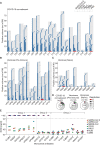ACE2-binding exposes the SARS-CoV-2 fusion peptide to broadly neutralizing coronavirus antibodies
- PMID: 35857703
- PMCID: PMC9348755
- DOI: 10.1126/science.abq2679
ACE2-binding exposes the SARS-CoV-2 fusion peptide to broadly neutralizing coronavirus antibodies
Abstract
The coronavirus spike glycoprotein attaches to host receptors and mediates viral fusion. Using a broad screening approach, we isolated seven monoclonal antibodies (mAbs) that bind to all human-infecting coronavirus spike proteins from severe acute respiratory syndrome coronavirus 2 (SARS-CoV-2) immune donors. These mAbs recognize the fusion peptide and acquire affinity and breadth through somatic mutations. Despite targeting a conserved motif, only some mAbs show broad neutralizing activity in vitro against alpha- and betacoronaviruses, including animal coronaviruses WIV-1 and PDF-2180. Two selected mAbs also neutralize Omicron BA.1 and BA.2 authentic viruses and reduce viral burden and pathology in vivo. Structural and functional analyses showed that the fusion peptide-specific mAbs bound with different modalities to a cryptic epitope hidden in prefusion stabilized spike, which became exposed upon binding of angiotensin-converting enzyme 2 (ACE2) or ACE2-mimicking mAbs.
Figures




References
-
- Lednicky J. A., Tagliamonte M. S., White S. K., Elbadry M. A., Alam M. M., Stephenson C. J., Bonny T. S., Loeb J. C., Telisma T., Chavannes S., Ostrov D. A., Mavian C., Beau De Rochars V. M., Salemi M., Morris J. G. Jr., Independent infections of porcine deltacoronavirus among Haitian children. Nature 600, 133–137 (2021). 10.1038/s41586-021-04111-z - DOI - PMC - PubMed
-
- Tortorici M. A., Walls A. C., Joshi A., Park Y.-J., Eguia R. T., Miranda M. C., Kepl E., Dosey A., Stevens-Ayers T., Boeckh M. J., Telenti A., Lanzavecchia A., King N. P., Corti D., Bloom J. D., Veesler D., Structure, receptor recognition, and antigenicity of the human coronavirus CCoV-HuPn-2018 spike glycoprotein. Cell 185, 2279–2291.e17 (2022). 10.1016/j.cell.2022.05.019 - DOI - PMC - PubMed
MeSH terms
Substances
Grants and funding
LinkOut - more resources
Full Text Sources
Other Literature Sources
Medical
Miscellaneous

